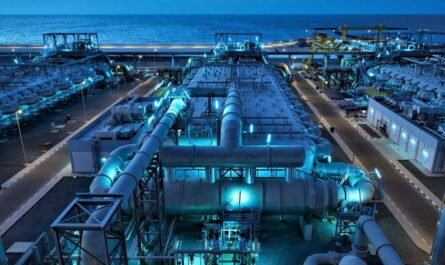Desalination refers to the process of removing salt and other minerals from seawater or brackish water to make it suitable for human consumption or irrigation purposes. There are two main global water desalination technologies used – reverse osmosis (RO) and thermal distillation.
Reverse osmosis involves pushing saltwater through a semi-permeable membrane that filters out the salt ions, leaving fresh water on one side. It requires less energy than thermal distillation and accounts for over 60% of global desalination capacity today. Global Water Desalination In RO desalination plants, pretreated seawater is pressurized to force it through thin film composite polyamide membrane barriers that remove unwanted salts and other impurities.
Thermal distillation methods like multi-stage flash distillation (MSF) and multi-effect distillation (MED) involve boiling seawater and condensing the vapor to produce freshwater. In MSF plants, seawater is heated in a series of flash chambers where it ‘flashes’ to steam in each subsequent chamber at a lower boiling point temperature than the previous one. MED plants utilize heat more efficiently using multiple effects where steam from one chamber heats the next, requiring less energy input.
Global Water Desalination
Currently, over 17,000 desalination plants globally have a total production capacity exceeding 100 million cubic meters of water per day. The Middle East leads the world in desalination, producing over 50% of the world’s desalinated water mainly due to its arid climate and growing populations. Saudi Arabia alone accounts for over 25% of global capacity and desalinates over 3 million cubic meters of water per day. Gulf nations are heavily reliant on desalination to meet up to 85% of their domestic water needs.
Asia-Pacific is another fast-growing regional market for desalination led by countries like China, India and Australia with scarce freshwater resources. China has over 1300 RO plants operating or under construction. Western Australia is dependent on desalination for over 50% of its water supply with four large seawater plants in operation. California also has over 50 desalination plants providing approximately 110 million gallons of potable water per day presently.
The global desalination is projected to exceed $25 billion by 2027, according to industry estimates. Population growth, climate change impacts, increasing urbanization and industrialization are driving up global freshwater demand. Countries across Africa, Latin America and the Caribbean are increasingly adopting desalination technology to overcome local water scarcity challenges. Over 300 new desalination facilities are under construction globally to help meet future shortfalls in access to potable water.
Environmental and Energy Impacts of Global Water Desalination
While offering a sustainable solution to freshwater shortages, desalination also poses environmental and economic challenges. Conventional thermal distillation plants powered by fossil fuels have high energy inputs and carbon footprints. Modern RO plants are more energy efficient but still consume approximately 3-4 kWh of power to produce 1 cubic meter of freshwater. At full global capacity, desalination could account for over 1% of global electricity use.
The brine discharge from desalination is another concern with high salt concentrations harmful to local marine ecosystems if not properly diluted and dispersed. Pre-treatment of raw seawater with chemicals like anti-scalants and chlorine also introduces pollutants into wastewater outfalls. Desalination plants are increasingly adopting mitigation measures like brine dilution tunnels, biofouling control through non-chlorine chemicals and brine concentrators to reduce environmental impacts.
Co-location with renewable energy sources offers promising prospects to decarbonize desalination. For example, solar and wind farms can power desalination plants located near coastlines with their energy production aligned to daily water demands. Breakthroughs in renewable-integrated desalination and energy recovery devices can further cut costs and carbon footprint of this critical water supply technology needed worldwide. Advanced Materials like graphene are also being studied to develop more efficient and durable desalination membranes in the future.
The Future of Global Water Desalination technology
As climate pressures intensify water scarcity worldwide, desalination innovations will play a vital role in ensuring freshwater security for billions. Countries are incrementally shifting to renewable-powered desalination plants to achieve long term water and energy self-sufficiency. Saudi Arabia has ambitious plans to install over 4.9GW of solar capacity dedicated to desalination before 2030. Chile and Israel are other pioneers combining desalination with solar power.
There is also potential to tap non-conventional water resources. Researchers are exploring removing salts from brackish aquifers, mine pit water and wastewater streams via desalination to augment freshwater availability in drought prone regions. Advances in forward osmosis and capacitive deionization hold promise to make desalination technologies even more energy efficient and affordable. With further R&D support, desalination is projected to meet 30% of worldwide water demand by 2050 helping address one of humanity’s most pressing global challenges.
*Note:
1. Source: Coherent Market Insights, Public sources, Desk research
2. We have leveraged AI tools to mine information and compile it.



